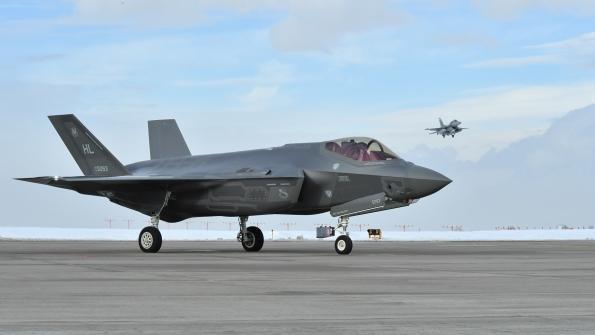
F-35A
The Czech government has approved the acquisition of Lockheed Martin’s F-35 Joint Strike Fighter.
After months of lobbying by the defense ministry and ministers, the government has OK’d the purchase of 24 aircraft for 106 billion Czech koruna ($4.58 billion), with deliveries planned from 2031.
The decision means the Czech Republic’s 14-strong leased Saab Gripen fleet will now need to serve until 2035, when the transition to the F-35 is due to be complete. This will extend the lease of the Swedish-made fighters well beyond 2027, when the contract was due to expire.
“It is an effective solution,” Czech Prime Minister Petr Fiala said of the F-35 after the decision was made on Sept. 27.
“The benefit of the capabilities of this system during its lifetime is significantly higher compared to the money we will pay than when purchasing another type of aircraft,” he said. “All real experts agree that fifth-generation aircraft will solve the future of our tactical air force for decades to come, in contrast to older generations of fighter aircraft.”
Along with acquiring the fighters, Prague is also gearing up to pay some 44 billion Czech koruna to rebuild the Caslav airbase, which will be the F-35’s main operating base, as well as train personnel, officials announced.
The Foreign Military Sale purchase will also include ground equipment, simulators and a weapons package.
Defense Minister Jana Černochová acknowledged that the cost was a high price to pay, but insisted it represents just 7.5% of upcoming defense spending between 2024 and 2034.
She maintained that other projects, such as the recapitalization of army mechanized brigades, would not be threatened by F-35 spending.
Černochová also says the government already has 14 industrial cooperation projects ready for Czech industry following negotiations with Lockheed Martin and engine manufacturer Pratt & Whitney. They include the “possibility of direct involvement in the global supply chain for F-35 aircraft.”
Prague originally announced it had selected the F-35 in July 2022. Černochová said at the time that the aircraft had been chosen because only “advanced, fifth-generation fighters will be able to meet mission requirements in future battlefields.”
The aircraft was deemed a “cost-effective solution” because it is already in service with several other European nations and has been ordered by others, including neighboring Poland. Officials said this would “strengthen cooperation, joint training and capability sharing.”
The same message was repeated by Lt. Gen. Karel Řehka, chief of the Czech military’s general staff, at a Sept. 27 press conference.
“We have to realize that with the large number of these machines that will operate in Europe and their interconnections, we will be able to use sensors and information from our allies,” Řehka said. “We’re talking about a network of more than 600 aircraft here, and that’s a force with major deterrence potential to deter a possible adversary from trying to attack us.
“Thanks to these aircraft, our army will be able to fully operate in all operational domains for the conduct of war and ensure the effective defense of the Czech Republic,” Rehka added.
But the decision to select the F-35 has attracted widespread criticism. Some have questioned whether the Czech Air Force will be able to make full use of the F-35’s capabilities, given that it currently uses its Gripen fighters for air defense and air policing.
Concerns have also been expressed around costs—not only the aircraft’s operating costs, which have been questioned by other customers as well as the U.S. and UK governments—but also the cost of transforming the Caslav base for F-35 operations.
The criticisms prompted an angry, 2,400-word rebuttal from the Czech defense ministry. It claimed that “inaccurate and misleading information” had been published and said the F-35 would be cheaper than operating the E-model Gripen, which was offered to the Czech Republic as an alternative to the F-35.
Selecting the Gripen E would have been more expensive than the F-35A based on the U.S. and Swedish government offers, the rebuttal document said. It noted that the prices stated by Lockheed Martin were “tens of percent less than for which the Swedish government officially offered us these planes.” Selection of the F-35, Czech officials said, was decided through an examination of seven criteria, of which price was one. “The F-35 finished first and the Gripen wasn’t even second,” the defense ministry said.
As well as replacing the 14 Gripens, the F-35s will also replace the Aero Vodochody L-159 Advanced Light Combat Aircraft (ALCAs) in service with the Czech Air Force.
The Czech Republic joins a growing list of Eastern European countries to adopt the F-35, with Poland ordering 32 aircraft and Romania planning to purchase 48.
Lockheed Martin said it was honored that the Czech Republic had selected the aircraft, and that its partnership with industry would “deliver benefits in research and development, manufacturing and sustainment.”
“The F-35’s growing presence across Europe is a powerful example of alliance-based deterrence and is setting the foundation for NATO and allied nation’s next-generation air power capability,” the OEM said in a statement.
Saab is yet to comment.





